This page is being developed, more information will be added from time to time
 Seaham Harbour North Dock pre 1899
Seaham Harbour North Dock pre 1899
History and Development of Seaham timeline
Pre-history:
Geological evidence shows that the the East Durham coast area was part of a tropical sea ............
In the Carboniferous Period, this area was part of a large continent that lay across the Equator. Low lying tropical swamps covered the land and dead trees and other plants built up as a layer of peat which eventually was covered in a layer of sand and mud. The peat, over millennia, was compressed and hardened to form a seam of coal and the sand and mud became sandstone and shale. This sequence of layering of peat, mud and sand eventually formed what is known as the Coal Measures that form the Northumberland and Durham Coalfield.
About 300 million years ago the land slowly moved north away from the equator and the climate became warmer and drier. This area became a barren desert covered in sand dunes; the remains of these dunes, the 'yellow sands' are quarried today as building sand.
A large part of the desert lay beneath sea level and around 260 million years ago in the Permian Period water from the surrounding ocean flooded in to create a shallow inland sea known as the Zechstein Sea. Over the following several million years the sea level rose and fell a number of times causing the Zechstein Sea to dry up.
A reef formed a barrier running roughly in a north - south direction separating a shallow lagoon to the west from the deeper water to the east. The reef can be seen today as a number of hills in the area including those at Tunstall in Sunderland and Beacon Hill south of Seaham. A large variety of animals lived on and within the reef and lagoon, tiny fragments of shell and skeletal remains built up as a lime rich mud on the sea floor. It is this lime rich mud that eventually became limestone. In places fossilised shells can still be seen in the rock.
During periods of falling sea levels the hot arid climate caused the sea water to evaporate to making it much saltier. Salt minerals known as Evaporites built up on the sea bed. Evaporites can be seen today in the limestone formations at Red Acre Point within Seaham Harbour Marina.
The text above is an extract from the "On top of a tropical reef" leaflet by courtesy of the Limestone Landscapes Project and Grondwork Northeast and Cumbria.
Early settlers:
The earliest occupation in the area dates to the Mesolithic period when the first settlers may have had temporary settlements close to the sea.
Roman period:
Although there is no recorded evidence of Roman settlement in Seaham it is highly likely that there has been some type of unrecorded Roman settlement here in the past. Several stones showing Roman workmanship can be seen within the tower of the early Anglo-Saxon church of Saint Mary The Virgin at the site of the village of Old Seaham. In 1912 it was also recorded in the parish registers that they had portions of a Roman roofing tile and paving tile. It has been frequently suggested that the headland east of the church was a likely candidate for the location of a Roman Signalling Station.
Around 1860 Angus Bethune, the Vicar of St Marys Church, was present at the opening of some "barrows" (Prehistoric Burial Mounds) near to the church. In each a relic was found such as a "quern", a handmill for grinding corn, and some pieces of Samarian Ware (red pottery). These mounds suggest that the area around Old Seaham was settled prior to the establishment of the church.
At Kinley Hill in Hawthorn a large number of Roman coins along with a small collection of other objects have been recovered by metal detectors in recent years [mid to late Roman period] suggesting an unrecorded settlement or military installation in the area.
When Seaham cemetery was being extended a hand quern and pottery fragments were found as well as part of a Roman road, again suggesting the presence of a Roman settlement. A number of finds of Roman date have been found close to the small farm at Slingley Hill. Coins and a brooch have been discovered in the 20th century. It may have been the site of a Roman settlement, or even a temple. A hoard of Roman coins was found not far to the north-east in the 19th century.
Saxon period:
Following the withdrawal of the Romans from Britain in the early 5th century AD settlers from northern Europe crossed the channel to populate southeastern England and by the early 6th century the Anglo Saxon peoples had travelled along the coast. There is some evidence of an Anglo Saxon settlement in the Easington area but it is more difficult to pin point settlements in and around Seaham.
Vikings and Danes:
The Milbankes and Lord Byron:
Ada Lovelace, the world's first computer programmer:
The Londonderrys:
Creation of Seaham Harbour:
Laying of the Foundation Stone, 28th November 1828
Friday last being the day appointed for the laying of the foundation stone of the new harbour and town of Seaham, an immense concourse of people, many of them from a great distance, assembled to witness the ceremony. Numerous flags were hoisted along the coast and a battery of patereros (small canon) was placed on one of the points of the harbour.
The scene was strikingly gay and animated, and very much resembled the eager bustle incidental to some great sporting movements on the turf, from the vast concourse of persons of all classes, and the numerous carriages that were assembled, even before the hour of 12o'cloc. The Marquis and Marchioness of Londonderry, accompanied by Lord Ravensworth and family, the Brandling family, Sir H. Browne, Sir C. Sharpe, Sir R.S. Hawks, Mr and Mrs Littlejohn etc.ect. and other distinguished friends, arrived in their carriages about one o'clock. Their arrival was announced by a salute of 19 guns from the battery and shortly afterwards the distinguished party were let down on the splendid rail-way carriage constructed for his Grace the Duke of Wellington last year, to that part of the harbour where the stone was suspended ready for its final position--- the band preceding them.
The Marquis having alighted, and Mr Buddle having taken his place on the foundation stone, and holding in his hand a superb silver trowel, thus addressed the noble Marquis-----
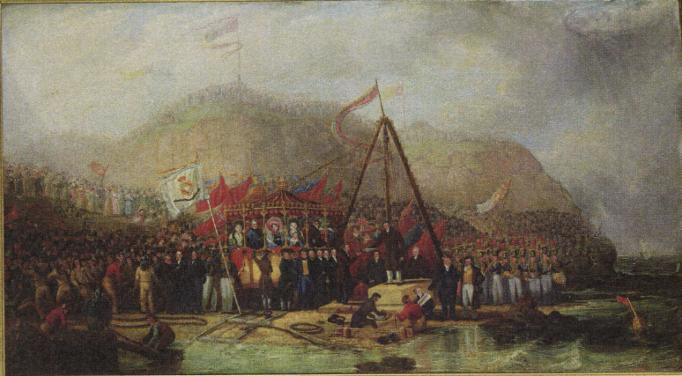
the laying of the foundation stone 28th of November 1828 by Robert Mackreth (1766 - 1860)
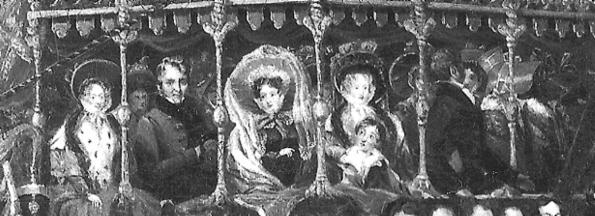
the watching party:
l to r: Miss S Liddel, Lord Ravensworth, Lady Londonderry and Miss E Liddel
My Lord-- I have the honour to present to your Lordship this small implement to be used in celebrating the commencement of a great undertaking. It seldom falls to the lot of an individual to be the founder of a work of such magnitude and importance as that of which we are now assembled to witness the commencement whether it be considered in a public or private point of view. As a private adventure, it holds out the most reasonable prospect of becoming highly and permanently beneficial to your Lordship, and to your family; and of thus affording the most gratifying as well as the most appropriate reward for the exhibition of that laudable spirit of enterprise which has stimulated your Lordship to embark in this great undertaking. (loud cheers) As a public work its advantages will be great. The facilities which the new harbour will afford to the commercial enter prize of this county must be apparent to everyone, and must be not less gratifying to your Lordship than to the Marchioness of Londonderry, whose feelings are always alive to everything which can contribute to the prosperity of her native county. (great applause) Another and by no means less interesting advantage will attend the work. It will become a harbour of refuge, into which vessels may flee for safety in times of difficulty and danger, and will thus be the means of preserving to their country, the lives of many valuable seamen. (cheers)
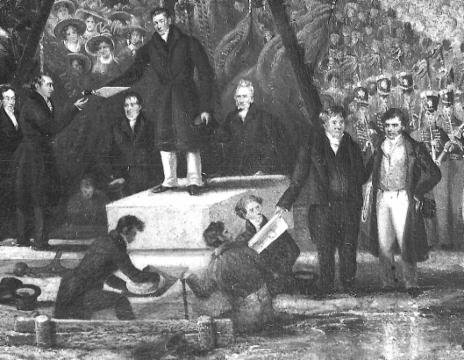
John Buddle addressing Lord Londonderry and presenting the silver trowel
The melancholy scene which we witnessed here four years ago is still fresh in our memories. On this occasion no fewer than eleven vessels were wrecked within the short space of a mile of the spot on which we now stand, and several lives were lost. I had opportunities of conversing with several individuals, who were on board the shipwrecked vessels, and they all expressed their opinion that had the harbour of Seaham been ready to receive them, every one of their unfortunate vessels would have escaped destruction.
I have the honour to address myself to a distinguished soldier, one who has nobly fought the battles of his country in the field and I feel assured that the recollection of the dangers he has thus so often braved, will tend to increase his anxious desire to rescue from danger of another kind, those intrepid men who are always ready, at the expense of their lives, to support their country's glory on the ocean. (loud acclamations)
Your Lordship will now proceed to lay the foundation stone of the east pier, which will form the chief feature of the harbour. Under the direction of our able engineer, Mr. Chapman, that stone will, I trust, be the nucleus of a great and useful work, and I shall conclude by the expression of my ardent wish in which I am sure all your Lordship's friends assembled will most cordially join that the work may be as stable as the rock on which the foundation stone is about to be laid, and that your Lordship and Lady Londonderry may long,very long, live to enjoy the benefits which will result from the undertaking as well as the gratifying reflection that you have rendered one more public benefit to your country. (immense cheering)
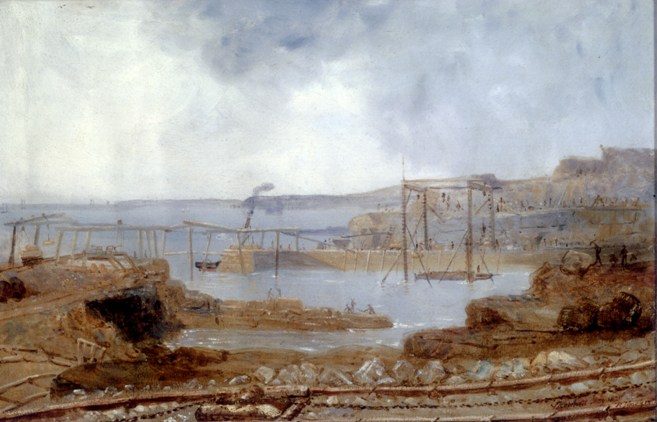
the building of Seaham Harbour by R. Mackreth (1766 - 1860), sketched May 1829
The opening of Seaham Harbour 2nd of August 1831
On Monday last, the new harbour of Seaham was opened, and although the opening was intended to be strictly private and attended with any ceremonial, yet the secret had transpired, and the anxiety of the public to witness this first essay was so great, that some thousands of the inhabitants of Sunderland, Shields, Stockton, Durham, and Newcastle were assembled to take an active part in the proceedings of the day. In the outer harbour, were twelve steam boats from the neighbouring ports, filled with gaily dressed company, and bands of music, and adorned with various coloured flags, and the inner harbour contained seven waiting for cargoes; amongst which was a beautiful new vessel, the grand object of attraction, called the Lord Seaham, of fifteen keels burthen. Her lading was completed about four o'clock, from and immense range of convenient staiths placed on the south side of the harbour- and as the time of high tide approached, the excitement of the public was intense, and the piers and banks were crowded with myriads of spectators, all anxiously awaiting to catch a glimpse of the first vessel which was to leave the harbour with a cargo of the staple commodity of the county. The signal was at length given, and she glided gently, steadily, and gracefully from the inner harbour, into the outer basin, where two steam-boats were stationed to tow her to sea. As she approached the mouth of the harbour, a grand salute was fired, Rule Britannia was struck up by the bands, and the immense assemblage testified their satisfaction by repeated cheers. Thus escorted (for the wind was adverse) the vessel cleared the entrance in gallant style, and as she advanced into the bosom of the deep, the cheers were renewed with redoubled vigour, and the crew responded to the utmost of their power. The sight was truly gratifying: the alarm which some had felt before she left her moorings, was completely dissipated, and the fears and doubts of all gave place to congratulation. The noble founder of the harbour was an anxious spectator on the south pier, and expressed himself perfectly satisfied with this first most propitious trial of his new harbour. The surprise and astonishment of those who had attend the ceremony of the laying the foundation stone on the 26th November, 1828, were extreme on beholding the wonderful transformation which had taken place in so short a period-- the dry land on which they then stood was now excavated, and vessels were moored in safety, and loading with facility: and a town had sprung up which has now nearly a thousand inhabitants, who have found a local habitation and a name where two years ago, there was not even a single cottage: and hundreds and thousands have received occupation and employment where the sound of the workman's hammer was never heard before.
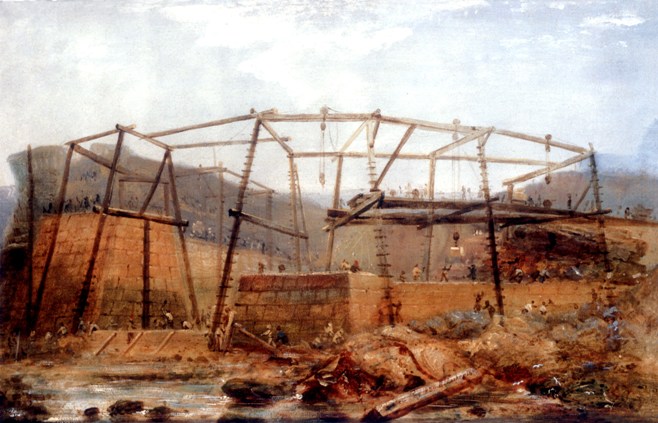
the building of Seaham Harbour dock gate and east quay by R Mackreth (1766 - 1860), sketched May 1829
THE DINNER-----At seven o'clock a large party sat down to dinner, at Seaham Hall, on the invitation of Mr. Buddle, who ably presided on the occasion ( the noble marquis wishing to be considered as a guest). There were present the collectors of the neighbouring ports, of Sunderland and Stockton, Mr. Chapman, the engineer, Mr Dobson, the architect, Mr. B. Thompson and Mr. Thackery, the contractors for the railway, Mr. Mackreth, who has decorated the dining-room with masterly sketches of the progress of the harbour from its commencement, the Rev. Mr. Cassidy and Mr. John Andrews, from Newtownards, Colonel Burke, Mr. Carr, Mr, Gregson, Mr, Wade, Mr. Harrison, Mr. Wilkinson, Mr. Wood, Mr. Spence (Vice President) and a numerous party of gentlemen from the neighbouring towns.
The repast was sumptuous and the venison from Wynyard was admired by the amateurs. The dinner was served on a new, splendid, and costly service of plate, which was presented on this occasion by the Marquis Of Londonderry to his Fiend and agent Mr. Buddle.
Among the toasts were " Prosperity to Seaham Harbour", ----- the "Noble Founder", ----- "the Marchioness of Londonderry", with an expression of regret that she was not present to grace a ceremony in which she would feel so lively an interest--" Lord Seaham"--- "Lord Adolphus Vane", and the junior branches of the noble family of Vane.
The president (aided in his efforts by the noble marquis) did everything in his power to contribute to the pleasure of the evening, and the party did not separate till a late hour, highly gratified with the events of the day.
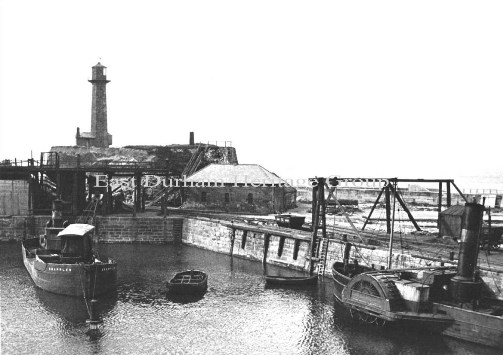
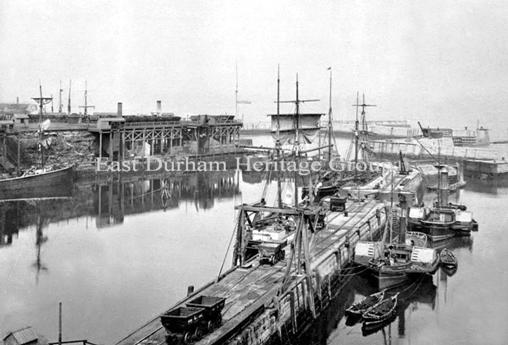
The Milbankes and Lord Byron
Ada Lovelace, the world's first computer programmer
A timeline, a summary of the first 100 years of the development of Seaham
1821 the Londonderrys arrive in Seaham
1825 Excavation of the North Dock commenced
1828 Foundation stones for the harbour and town laid
1829 Golden Lion, first house in Seaham Harbour completed
1829 First ship The Brothers sailed into Seaham with a cargo of bricks
1831 First shipment of coal made from Seaham North Dock
1833 Seaham to South Hetton railway line opened
1835 The South Dock opened
1835 Seaham's first wooden lighthouse burnt down
1836 A passenger service started calling at Newcastle and Stockton
1840 North Dock completed
1843 Seaham Harbour parish created
1843 First coal from Murton Colliery shipped from Seaham
1845 Sinking of Seaton Colliery commenced
1848 Building of Bath Terrace begun John Dobson, Architect
1852 Six died in explosion at Seaham Colliery
1853 Construction of Seaham to Sunderland railway begun
1861 The Police Station and Magistrates Court opened in Tempest Road
1870 Seaham's first lifeboat The Sisters Carter of Harrogate arrived
1871 21 miners killed in an explosion at Seahm Colliery
1880 164 miners and 180 pit ponies killed in the Seaham Colliery disaster
1890 The Prince and Princess of Wales visit Seaham
1899 Sinking of Dawdon Colliery shaft begun
1901 The population of Seaham reached 10,000
1905 The new South Dock was opened by Prime Minister Balfour
1905 The first train ran from Sunderland to Hartlepool via Seaham
1907 Silent films were first shown at the Co-operative Hall
1908 Seaham Amateur Operatic Society formed
1911 The population of Seaham reached 15,000
1912 The Empire, Seaham's first purpose built cinema was opened
1915 Seaham Hall used as a hospital during World War 1
1916 One person was killed when a German submarine shelled Seaham
1921 Seaham's Candlish Bottleworks closed
1922 The statue of the 5th Marquess of Londonderry unveiled
1923 The sinking of Vane Tempest colliery shaft begun
1924 The Londonderry Engine Works closed
1925 The Castlereagh coal staithes build in the South Dock
1927 Seaham Hall given by the Londonderrys to Durham County Council for use as a hospital for women and children
1929 The first coal drawn from Vane Tempest Colliery